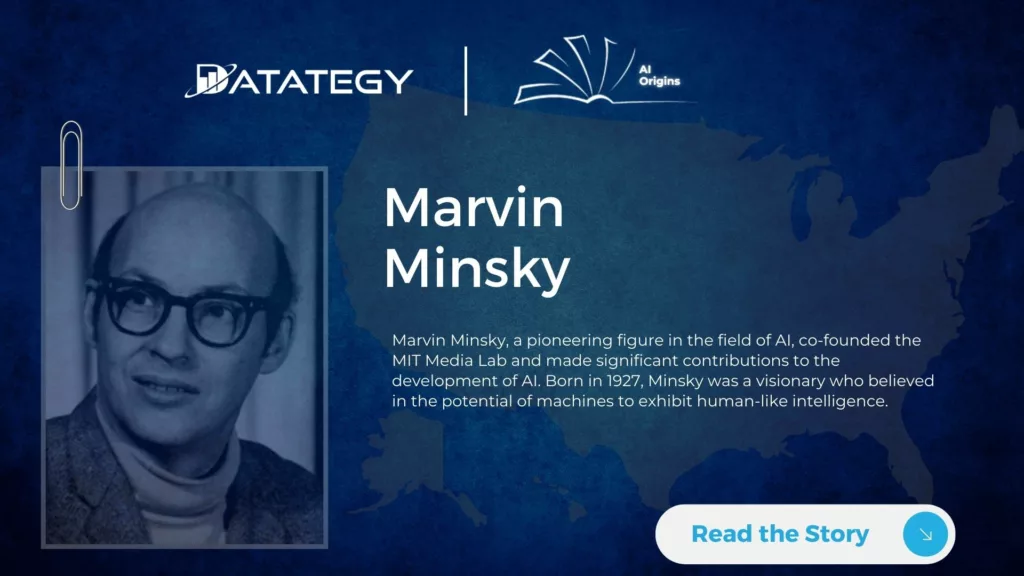How Law Firms Use RAG to Boost Legal Research RAG...
Read MoreAI Origins: Marvin Minsky
Table of Contents
ToggleWelcome to ”AI Origins “ series. In this collection of articles, we take you on an inspiring journey through the history of artificial intelligence, focusing on the remarkable individuals who have played a crucial role in making AI accessible to everyone.
Throughout these articles, we’ll dive into the life stories and contributions of these innovative minds who have reshaped the AI landscape, paving the way for a more inclusive and transformative future. Join us as we celebrate the human ingenuity behind the AI revolution and explore the extraordinary individuals who have made it all possible.

Marvin Minsky, a pioneering figure in the field of artificial intelligence, co-founded the MIT Media Lab and made significant contributions to the development of AI. Born in 1927, Minsky was a visionary who believed in the potential of machines to exhibit human-like intelligence. His work laid the foundation for many concepts that are fundamental to AI today.
Marvin Minsky Key Data
| Date | Event |
|---|---|
| 1927 | Born in New York City |
| 1951 | Received B.A. in Mathematics from Harvard University |
| 1954 | Earned Ph.D. in Mathematics from Princeton University |
| 1956 | Co-founded the MIT Artificial Intelligence Project |
| 1961 | Developed the first randomly wired neural network learning machine, SNARC |
| 1969 | Published "Perceptrons" with Seymour Papert, criticizing the limitations of neural networks |
| 1970 | Awarded the Turing Award for his contributions to AI |
| 1985 | Co-founded the MIT Media Lab |
| 1986 | Published "The Society of Mind," outlining a theory of mind based on interactions of simple components |
| 2016 | Passed away in Boston, Massachusetts |
Marvin Minsky's role in the "Frames" Concept
Minsky made groundbreaking contributions to knowledge representation through his development of the “frames” concept in the mid-1970s. Frames are data structures for representing stereotypical situations. For instance, a “birthday party” frame would include roles such as the host, guests, presents, and cake, along with typical interactions and expectations. This approach allowed AI systems to organize and utilize information more effectively, simulating a form of human-like understanding and reasoning. The concept of frames influenced the development of expert systems and other AI applications that require structured knowledge.
Among his contributions to robotics was the creation of the first autonomous machines, created by Minsky. His 1951 creation of the stochastic neural-analog reinforcement calculator, or SNARC, is one prominent example. One of the earliest machines to mimic a neural network and show how learning occurs through reinforcement was this one. The significance of sensory input and feedback mechanisms was highlighted by Minsky’s avant-garde approach to robotics, which has since become a cornerstone of the discipline.
Benefits of the "Frames" Concept
| Benefits | Description |
|---|---|
| Structured Knowledge Representation | Frames allow information to be organized into structured units, making it easier to manage and retrieve relevant data. Each frame represents a stereotypical situation, such as a "birthday party," with predefined roles and expectations. |
| Contextual Understanding | Frames provide context for interpreting data, enabling AI systems to understand and respond to situations more accurately. For instance, knowing the context of a "restaurant" frame helps the system anticipate interactions like ordering food or paying the bill. |
| Efficient Information Processing | By organizing knowledge into frames, AI systems can quickly access and process relevant information, improving efficiency. This structured approach reduces the complexity of decision-making and problem-solving processes. |
| Enhanced Reasoning Capabilities | Frames facilitate reasoning by providing a framework for making inferences based on the relationships and attributes within a frame. This allows AI systems to draw conclusions and make predictions more effectively. |
| Modularity and Reusability | Frames promote modularity, allowing individual frames to be reused across different applications and scenarios. This modular approach supports the development of more versatile and adaptable AI systems. |
| Human-Like Understanding | Frames simulate human cognitive processes by representing knowledge in a way that mirrors human understanding. This enables AI systems to interact with users more naturally and intuitively. |
In overall, Marvin Minsky’s innovative theories and research have had a significant impact on the field of artificial intelligence, influencing both the field’s scholarly research and practical applications. Future generations of AI practitioners and researchers continue to be guided and inspired by his work.
Interested in discovering papAI?
Our AI expert team is at your disposal for any questions
How RAG Systems Improve Public Sector Management
How RAG Systems Improve Public Sector Management The most important...
Read MoreScaling RAG Systems in Financial Organizations
Scaling RAG Systems in Financial Organizations Artificial intelligence has emerged...
Read MoreHow AgenticAI is Transforming Sales and Marketing Strategies
How AgenticAI is Transforming Sales and Marketing Strategies Agentic AI...
Read More


